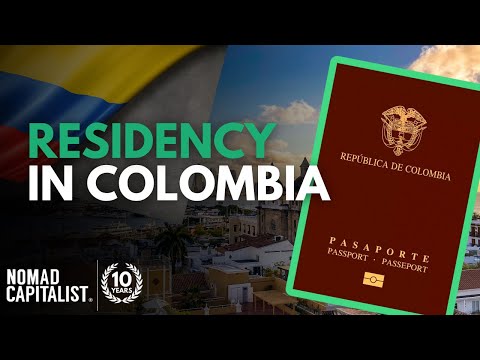Nomad Guide to Living in Colombia
January 23, 2025
Multinational corporations and expats are making the transition to Colombia’s upscale living and bustling economy. Towering Andean peaks, mythical Amazon jungles, and pristine coastline all fuse into this economic and cultural hub.
Endless landscapes, activities, and opportunities unfold for expats arriving in Colombia. This country is built for any kind of lifestyle, whether you want to retire by the coast or create a startup in the metropolis.
Set aside the stereotypes because Colombia has turned a new page and is ready to leave its dark past in the past. Increased security has provided worldwide expats and visitors a safe country to explore, from its vast scenery to its sophisticated cities.
Would you like access to one of the most interesting locations in South America? Would you like to find property in a more emerging market?
When it comes to international investment and second passports, there is no universal solution that fits everyone. The Nomad Capitalist approach involves creating a holistic plan that takes into account your specific circumstances. Apply here today to start creating your strategy with our team, designed to optimize your tax rate, support your business endeavors, and fulfill your and your family’s needs.
The Cost of Living in Colombia
Colombia offers an excellent, low-cost, up-scale living ratio. In a country where one would expect otherwise, an array of first-world amenities and infrastructure exists.
Rent and cost of living will vary from place to place, but in general, you can expect the following to be true:
Dining out during lunch hours will cost you about $6 for the traditional Colombian lunch (soup, main, drink, and dessert). That can, of course, cost more depending on the areas where you dine.
Dinner will cost between $10 – $21 a plate in a touristy area. However, the options are as vast as they are rich in variety.
There are many options for transportation in almost any part of Colombia. Bogota’s traffic is known to be stressful during rush hours, so it’s advisable to travel at other times if possible. City buses will cost you around $0.60-$0.90 one way, while taxis generally cost around $1.50 per kilometer in the cities.
Rent in cities like Medellín and Bogota runs around $400-$1,000 for an average apartment. Nicer flats designed for expats can be rented for around $1,500-$2,000 per month. Utilities are reasonable and should only cost around an average of $70/month for gas and electricity.
Groceries costs vary depending on location. However, a couple can expect to pay around $400/month in food. A liter of milk in the grocery store will cost about $1.16, one dozen eggs around $2, and a mid-range bottle of red table wine around $10.
The Best Places to Live in Colombia
Medellín
Medellín has undergone significant changes, and it is now a vibrant and entrepreneurial city, being dubbed the ‘World’s Most Innovative City’ back in 2012 by Citi and Wall Street Journal.
A growing number of expats, tourists, and entrepreneurs are flocking to the city’s endless spring weather and cosmopolitan lifestyle.
A promising IT hub awaits, built on free after-school computer programming lessons and other government-funded programs. A strong educational culture with a blossoming arts scene provides a fresh and inventive workforce. Enjoy the variety of coffee shops, restaurants, and boutiques to really experience the local culture.
Santa Marta
Santa Marta is perfect for those looking to retire or unwind from the daily grind. This paradise on earth is complete with tropical rainforest, snow-capped mountains, and a Caribbean coast. Tayrona National Park protects these pristine landscapes.
One of the oldest surviving cities in South America, Santa Marta has become a developed city many property buyers descend upon for its choice of real estate. The largest urban city on the Caribbean coast in Colombia, Santa Marta’s economy is based mainly on trade, tourism, fishing, agriculture, and port activities.
Bogota
This tropical highland is the capital of Colombia and home to over 11 million people in its metropolitan area. Home to many business headquarters, Bogota conveniently lies just five hours by plane from New York, Mexico City, and Sao Paulo. In the north, many areas of the city have chic and sophisticated neighborhoods.
La Candelaria is the city’s cultural epicenter, where the historic cobblestoned streets lead you through the numerous museums, restaurants, churches, and convents.
Cali
Cali is the largest city in Colombia, after Bogota, with 3 million inhabitants. Founded in 1536, it contains a bustling industry of coffee, sugar, meats, cotton, tobacco, textiles, paper, and more — all of which are traded and produced here.
The world capital of salsa, Cali, pulses with its infectious salsa clubs and urban culture. This is Colombia’s only major city that gives access to the Pacific coast. It’s Colombia’s Southwest economic hub with one of the country’s fastest-growing economies.
Colombia is an increasingly popular destination for both foreign investment and expat living.

Business and Startups in Colombia
Colombia is among the leaders in Latin America when it comes to entrepreneurship, abundant natural resources, and a growing middle class. It’s true that things move at a slower pace here — and the country still relies heavily on oil, sugar, and coffee exports to sustain its economy — but a surge in its tech industry over the last decade has brought in many international companies and investors.
The Colombian IT market is expected to generate approximately $2 billion in revenue by the end of 2023 and increase to $3 billion within the next five years, with a growth rate of 9.15%.
It’s now home to around 3,600 IT companies. Google, Meta, and Microsoft have all established offices in Bogota.
Digital talent initiatives have produced a talented and educated workforce for startup companies, with thousands of Colombians receiving post-graduate degrees in engineering and computer science programs every year.
The Colombian government has been building the market over the years. In addition, it invested billions of dollars to expand its high-speed broadband access to a greater amount of Colombia.
Initiatives like the one launched by Mark Zuckerberg back in 2013 allowed smartphone and tablet users free access to the internet without data charges, providing businesses with a greater connection to a wider workforce. Locals now have access to more opportunities for employment and educational programs, particularly in the tech world.
Colombia is steadily developing its infrastructure to create a booming tech ecosystem. In fact, the whole Colombian economy is doing quite well. Colombia is one of Latin America’s strongest and fastest-growing economies.
Despite the challenges, Colombia is staying steady in its long-term goals and has a growing number of advantages in producing a worldwide competitive market.
Colombia’s Vibrant Culture
With around 48 million people and 440,000 square miles, Colombia includes an Atlantic and Pacific coast, islands, rain forests, Andean peaks, and plains. It connects to Central America via Panama and borders Peru, Ecuador, Brazil, and Venezuela.
The food in Colombia is as rich in variety as its different regions. Depending on where you are located, you can expect to enjoy classic dishes that include grilled meats, chorizo, beans, rice, and fresh avocado and tomato. Many soups are served in a traditional manner, which will typically include chicken and potatoes. In coastal areas, an array of seafood is abundant. Various fish and lobsters are served with coconut rice and sweet plantain patties.
Spain’s influence is still seen in many aspects of Colombian culture. For instance, Catholicism continues to be the main religion. Spanish is the primary language, and offshore business people and expats enjoy the fact that Colombians do not have a strong accent. In fact, they speak clearer Spanish than many other parts of Latin America.
While Colombia’s architecture reflects its 17th-century Spanish colonial roots, the 19th century brought an entirely new style known as the republican — a movement that represented the independence of Colombian art. Art is ornate and innovative with a strong historical background. Jewelry, paintings, fabrics, and sculptures are long-recognized traditions of Colombia, dating back to over a millennia ago.
The literary art scene is known worldwide with authors like Jorge Isaacs and Nobel Prize winner Gabriel Garcia Marquez, author of 100 Years of Solitude. The music scene throughout Colombia comes from a mix of influences, including African, European (mainly from Spain), native indigenous, and American.
Cumbia and salsa are danced in spicy clubs throughout the country, while bigger cities offer up a modern taste of nightlife in various bars and discotecas.
Safety in Colombia
Cities like Medellín are turning a new page with heightened security and city transformations, including newly built public libraries, schools, and parks city-wide. The homicide rate has decreased significantly since the 90s and has been stable since 20214. Innovative and sustainable transportation provides safer and quicker ways for people to commute throughout the city.
In 2022, there were approximately 26 homicides per 100,000 inhabitants in the country, down from a homicide rate of 26.8 a year earlier. The homicide rate in Colombia has been stable since 2014, with the numbers varying between 24 and 26.8 homicides per 100,000 inhabitants.
While its infamous dark past and crime rates have diminished over the last few decades, they’re not obsolete by any means. Cities like Bogota still struggle with theft and street muggings, which have increased since 2007. However, the rural areas of Colombia are traditionally known to present a higher risk of gang and terrorist-related activity than Colombia’s major cities.
On a positive note, Forbes included Colombia in its list of The 23 Best Places To Travel Around The World In 2023. The country has noticed the increased publicity and has prioritized security in its major cities. Most expats say that the areas where they go in Colombia feel perfectly safe.
Real Estate and Housing in Colombia
Bogota, Medellin, Cali, Santa Marta, and more are all cities equipped with great infrastructure and a decent real estate market for investing. Recent government incentives to invest in real estate can land you citizenship in the country with little effort.
Medellín and Bogota are among the Cheapest Cities in South America on a per-square-meter basis. With the excellent business and real estate opportunities in Colombia, people are beginning to take notice, as shown in prices that have doubled since 2006.
Property in Colombia is still highly affordable. Regardless, we still suggest you seek out a trustworthy professional for your real estate planning to help navigate complexities and avoid property scams.
Once you find the proper connection, real estate in Colombia can be a great deal for open-minded expats and investors looking to relocate or for good property rental yields.
Second Citizenship in Colombia
Expats and investors desiring a second citizenship can obtain citizenship in Colombia in as little as 5 years. This will require an investment in either property or business in the country itself and at least one visit to Colombia each year in order to keep your residency active.
After spending as little as five years in the country, you can apply for naturalization. A Colombian passport is much better than it used to be and will grant you visa-free access to over 130 countries, including Europe’s Schengen Area and traditionally difficult countries.
As a dual citizenship country, you will not have to renounce your current citizenship to become a citizen of Colombia.
For more information on obtaining residency and citizenship in Colombia, visit this page or apply for help.


How to Get UAE Citizenship – The Complete Guide
Sovereignty – both national and personal – shapes ambition, secures wealth, and defines status in a shifting global order. For the high-achieving global citizen, acquiring a second or even third passport is more than a lifestyle upgrade; it’s a strategic move in long-term financial and geopolitical positioning. But not all citizenships are created equal – […]
Read more

A Gateway to Central Asia: New Kazakhstan Golden Visa Program for 2025
Central Asia just raised the stakes in the golden visa game. In May 2025, Kazakhstan officially launched a 10-year Golden Visa program in an ambitious move to position the country as a serious contender in the global investor migration space. At a time when other international regions are rolling back their citizenship and residency options, […]
Read more

Top Countries Offering Golden Visas in 2025
Residency is no longer about lifestyle – it’s about leverage In an increasingly unpredictable world, Golden Visas offer something most governments can’t: certainty in exchange for capital. They are more than migration tools; they are strategic safeguards offering residence rights, future citizenship, global mobility, and access to tax-friendly jurisdictions. For investors, entrepreneurs and globally minded […]
Read more





